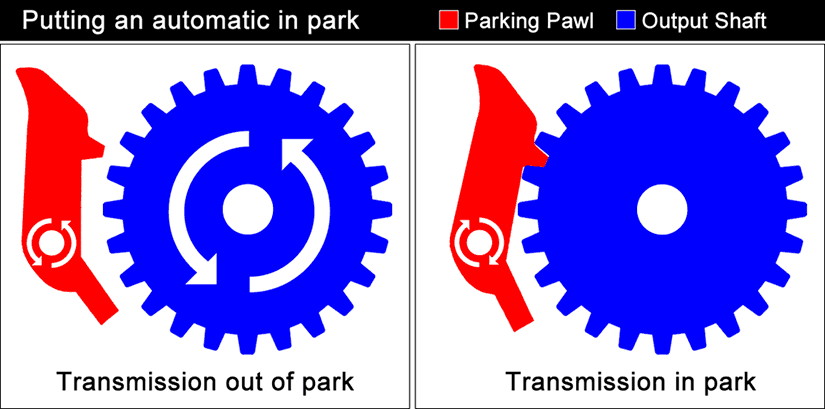There’s often some confusion about using ‘Park’ (P) on an automatic car. This guide aims to explain when to use Park, the purpose of Park in an automatic transmission and other frequently asked questions.
When to Use Park in an Automatic Car
You should generally use Park in an automatic car when you:
- Stop and exit the vehicle
- Stuck in a stationary traffic queue for an extended period of time
What Happens When You Put an Automatic Car in Park?
When you put an automatic car in Park (P), the transmission is locked by a metal pin called a transmission parking pawl. Inside an automatic car’s transmission is an output shaft, the output shaft is connected to the road wheels. The transmission parking pawl locks the output shaft and prevents it from rotating, which in turn prevents the road wheels from moving.

Putting an automatic in Park prevents the engine’s power from reaching the road wheels. By selecting Park, it also helps to prevent the vehicle from rolling. However, it’s important that you do not rely only on the Park function to secure the vehicle from rolling.
Will an Automatic Car Roll in Park?
The parking pawl pin that locks an automatic car’s transmission will secure against vehicle roll on a slight slope, but on a steeper gradient, due to the entire weight of the vehicle being secured only with the parking pawl, there is a risk that it may break. If the parking pawl breaks and the parking brake is not engaged, the car will roll.
Do You Need to use the Parking Brake with an Automatic?
When parking up in an automatic car, you should always use the parking brake and shift the gear lever into Park. Relying solely on shifting the gear lever into Park to secure your vehicle has risks. Excess wear can cause the transmission’s locking system to fail, or an ageing parking pawl may break if parked on a slope, or if your car is nocked by another vehicle.
By engaging the parking brake along with Park on the gear selector, your automatic car will be secure due to the vehicle brakes being applied and the transmission being locked.
When stopped and leaving your vehicle, avoid leaving the transmission in Neutral as this will not lock the transmission. See difference between Neutral and Park in an automatic car.
Should I put My Automatic in Park at Traffic Lights?
You would generally shift into Park only when you park and leave the vehicle. In general driving, such as stopping at traffic lights, leave the gear selector in Drive and simply hold the car using the footbrake.
Holding an automatic car with the footbrake while in Drive will not cause wear to the vehicle’s brakes. Brakes tend to wear when the pedal is applied after prolonged pushing from high speed as this generates significant heat. The creep function of an automatic car allows you to slowly move forward and stop with minimal wear to the brakes.
Additionally, rather than a clutch that’s used in manual cars, automatic cars use a torque converter. This device transfers power from the engine to the transmission using transmission fluid, this is why the car creeps forward at slow speeds. Torque converters are designed to slip, but unlike a manual car that has carbon discs for a clutch that do wear and need replacing, the torque converter uses high pressure transmission fluid meaning very little wear takes place.
What if I Stop at Traffic Lights at Night?
At night, brake light glare can be problematic for some drivers. If your vehicle, along with the following vehicle has come to a stop in a queue of traffic, select Neutral, apply the parking brake and remove your foot off the footbrake to deactivate the vehicle brake lights. This will minimise glare to road users behind, until the traffic moves again.
Should You Always Leave an Automatic Car in Park?
You should always leave an automatic car in Park when you have stopped and getting out of the vehicle. This will ensure that the transmission is locked. By also applying the handbrake, your car will not be at risk of rolling.
Why Does my Car Move When I put it in Park?
An automatic car can move when Park is selected. This is because when the transmission is shifted into Park, the parking pawl lever is lowered onto the ring of teeth on the output shaft. But if the parking pawl does not land directly between the teeth, the car may move slightly until the parking pawl slots into the next gap between the teeth. You will often hear a click, which is the parking pawl slotting into place and then the car will stop moving.
Parking an Automatic Car
When you park an automatic car, you should:
- Keep your foot firmly pressed on the footbrake
- Set the parking brake
- Shift the gear lever into Park
The reason that you shift into Park after applying the parking brake is because by shifting into Park, the transmission gets locked and it’s best to secure the weight of the vehicle first by using the brakes, rather than the transmission.

Excellent article on how to park a car with automatic transmission. Thank very much.